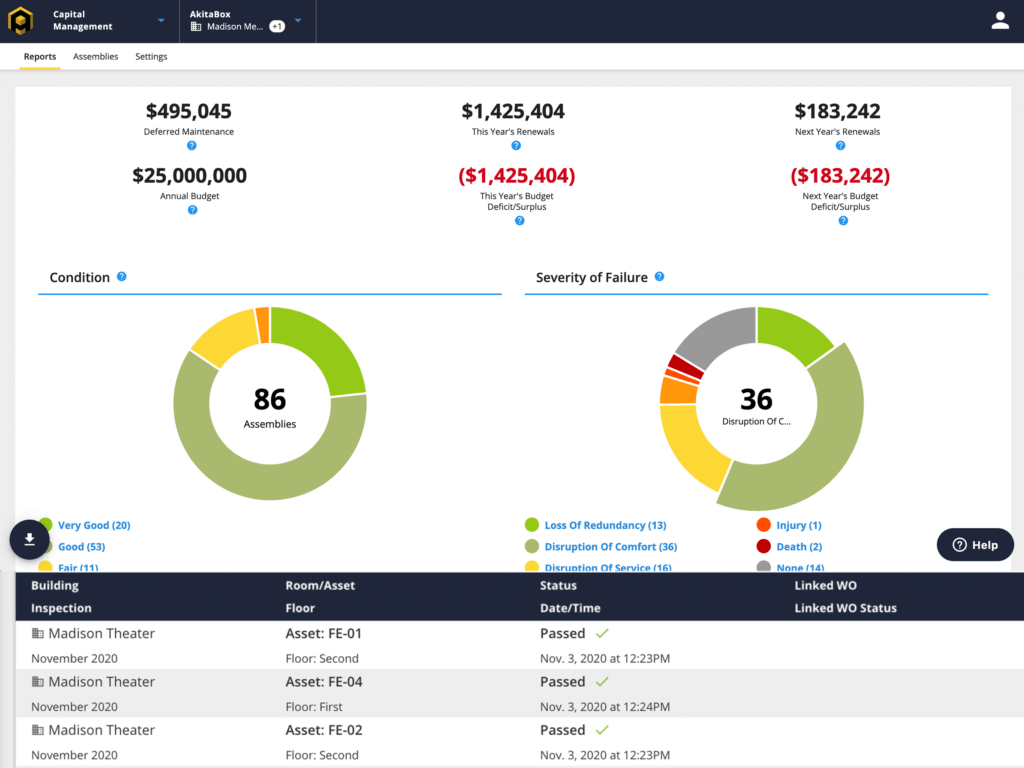
Money is tight – and facilities teams are especially feeling the pinch. Higher education operating budgets have plummeted 9 percent since 2019. Facilities investment shortfall to anticipated demands is approaching 40 percent, meaning facilities departments are left with only about 60 percent of the funds required.
If you want a bigger piece of a smaller budget pie, you’d better come with receipts. A spreadsheet of numbers based on iffy data and guesswork isn’t going to convince your campus finance gurus to hand over more dough. Getting the budget requires:
- Accurate facilities data specific to your campus;
- Clear priorities of what costs must be kept and which can be cut (and the ramifications); and
- A professional, persuasive and easy-to-understand presentation to the decision
Let’s explore how to build and present a data-driven facilities budget that’ll increase your chances of getting the funding you request.
Good data delivers better budgeting insights
Know what you can defer and what you can’t
Higher education facilities face an estimated $112 billion in urgent deferred maintenance needs. These unaddressed issues can impact your school’s ability to recruit students and attract faculty.
Basing your deferments on precise facilities data makes it more obvious which less vital issues can be delayed and spotlights the most important concerns to address whether for safety, compliance or student satisfaction reasons.
Properly time asset replacements
Once an asset exceeds its useful lifespan, it’s more expensive to maintain it than replace it. Accurate facilities data shows when an asset will reach end of life so you can budget for a new one. You also can more easily identify assets that are already past the end of life and are slowly bleeding capital reserves dry due to their more expensive maintenance needs.
Assign priority correctly
You probably won’t get all the budget dollars for which you asked. Thankfully, complete, accurate facilities data makes it much easier to assign priority to items in your budget. If you’re asked to reduce your budget request by 20 percent, you’ll know which things can be dropped without endangering campus safety and student satisfaction.
Establishing a priority system for facilities projects helps your team stay focused on long-term goals and keeps your priorities consistent from budget to budget. The list could look something like this:
- Fulfill requirements to meet all regulatory, legal and safety compliance
- Fulfill requirements to protect institutional financial integrity
- Complete ongoing projects
- Maintain or replace worn-out equipment
- Other projects
No more starting from scratch
Without an always-current view of facility conditions, you’re forced to reassess your capital allocation with every budget cycle. Starting your budget planning from square one every year consumes huge amounts of time.
With access to real-time facility data, there’s no need to build a budget from nothing. You already have all the current facility condition data you need to determine where to spend (and not spend).
“Well, that’s great,” you may be thinking. “But just how am I supposed to get all this accurate facilities data? My current data is a mess.”
It is possible to get there. You just need the right tools.
Software to the rescue
Facilities management (FM) software and capital management (CM) software work together to deliver data-driven budgets.
FM software tracks, collects, organizes and shares accurate, up-to-date facilities information. It pulls together multiple data streams (maintenance activities, asset conditions, etc.) to deliver a clear picture of your overall situation.
Taking all that information one step further, CM software uses your facilities data to help you identify key areas for investment, assign priority to spending needs and run various budget scenarios.
Imagine the power of having all this at your disposal. With FM and CM software (and the data they contain), you can:
- Create more exact facilities budgets
- Justify every item in your budget with accurate data
- Illustrate the costs and risks of deferring capital purchases and projects
- Give data-backed input to your leadership and finance
- Serve as a trusted resource for any facilities-related questions
Presenting a data-driven budget to campus leadership
Now for the most important part: Presenting your facilities budget to the campus decision makers.
Typically, the powers that be will assume you’ve asked for more than you need and will cut your request accordingly. Without accurate data to backup the budget and no way of seeing the urgency of specific requests, they view it as nothing more than just another line item.
Coming prepared with data specific to your unique campus brings your budget to life for people who don’t live and breathe facilities every day like you do.
Leveraging FM and CM software lets you visually showcase the “why” behind your budget requests and tell the story of your facilities’ needs.
Keep these 3 tips in mind when presenting your budget:
1. Show how your budget aligns with the strategic priorities of the institution. Whether your college is focused on improving student housing or stepping up its research game, explain how your budget items will directly support those goals.
2. Present easy-to-understand visual illustrations of your budget. Pie charts, bar graphs and tables are the native language of finance people. With CM software, you can highlight various aspects of your facilities budget using professional graphics, reports and predictive models. Want to convey what your current deferred maintenance backlog looks like? There’s a visual for that. It’s a great way to bridge the divide between how facilities and finance communicate.

3. Explain the risks of saying no to any particular line item. Don’t just take “no” for an answer; encourage additional discussion by showing campus leaders what “no” actually means for your facilities. Leverage the visual reporting in your CM software to highlight the impact of spending more or less on a particular issue. Outline the pros and cons of a “no” decision to ensure everyone at the table is making an informed choice.
You’ve got this
Download the free AkitaBox ebook to learn even more about accurate and effective capital planning in higher education. And if you’re looking for software for your next budget cycle, check us out!
